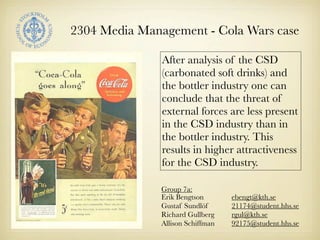Sse colawars group7a_2011
- 1. 2304 Media Management - Cola Wars case After analysis of the CSD (carbonated soft drinks) and the bottler industry one can conclude that the threat of external forces are less present in the CSD industry than in the bottler industry. This results in higher attractiveness for the CSD industry. Group 7a: Erik Bengtson ebengt@kth.se Gustaf SundlÃķf 21174@student.hhs.se Richard Gullberg rgul@kth.se Allison Schiffman 92175@student.hhs.se
- 2. Presentation outline âĒ CSD industry analyzed according to Porters Five Competitive Forces âĒ Conclusion âĒ Bottler industry analyzed according to Porters Five Competitive Forces âĒ Conclusion and comparison âĒ Future challenges for the industry
- 3. Threat of new entrants Bargaining power CSD Bargaining power of suppliers industry of buyers (Coke, Pepsi, etc) Threat of substitute products or services
- 4. CSD industry analysis CSD Products relevant: Carbonated beverages industry (Coke, Pepsi, etc) Geographic scope: United States market Level of rivalry: Saturated market resulting in high rivalry Major actors Coca-Cola and Pepsi accounted for 76% of the US CSD market share in 2000. (YofïŽe, 2004. Cola Wars Continue)
- 5. Bargaining power of suppliers Bargaining power of suppliers Size matters - power of major corporations like Coke and Pepsi provides a beneïŽcial advantage in negotiations. Standardized commodity products result in many suppliers lowering switching costs for CSD companies. Bargaining power of suppliers -> low Threat of new entrants Threat of new entrants Relatively low capital investment required Major capital investment needed for market success (marketing, building brand equity) -> relatively low threat
- 6. Bargaining power of buyers Bargaining power of buyers Concentrate producer -> Bottler -> retailer -> customer Hence, bottlers are the buyers Franchise agreements with Coca-Cola and Pepsi For successful sales to retailers, bottlers are heavily dependant on the major CSD producer brands -> low bargaining power Threat of Threat of substitutes substitute products or services Substitutes: all non-alcoholic beverages (non-CSD) Given a ïŽxed consumption per capita, substitutes like bottled water and juices have kept rising, whilst the CSD industry has slowed down since the late 1990âs. -> high threat of substitutes
- 7. Conclusions Porter analysis indicates multiple beneïŽcial forces (suppliers, buyers and new entrants). The CSD market has been a very lucrative and attractive industry for the past century. However emerging threats of substitutes and increasing rivalry within the industry, makes for a uncertain proïŽt potential given the current strategy.
- 8. Threat of new entrants Bargaining power Bottler Bargaining power of suppliers industry of buyers Threat of substitute products or services
- 9. Bottler industry analysis Bottler industry Products relevant: bottling service of CSD concentrate Geographic scope: United States market Level of rivalry: Many bottlers of similar size, high exit barriers due to committed resources resulting in high level of rivalry.
- 10. Bargaining power of suppliers Bargaining power of suppliers Heavily dependent on CSD producers result in very high bargaining power of suppliers. Threat of new entrants Threat of new entrants High capital investment to establish bottling plant and long term contracts for existing bottlers result in low threat of new entrants.
- 11. Bargaining power of buyers Bargaining power of buyers Buyers sell the bottled products to end customers and thereby control the exposure of bottled products directly inïŽuencing sales. High bargaining power of buyers. Threat of substitutes Threat of substitute products or services No apparent threat of substitutes. Low Soda Stream?
- 12. Conclusions and comparison ProïŽtability differs greatly. Bottler proïŽtability is heavily affected by both suppliers and buyers high bargaining power, resulting in low margins. CSD producers are less inïŽuenced negatively by external forces leaving them with higher margins. After ïŽve-force analysis one can conclude that the CSD industry is more proïŽtable than the bottling industry. Attractiveness based on proïŽtability is greater with the CSD producers.
- 13. Future challenges for the industry ->1990âs beneïŽcial rivalry Recently saturated market may decrease proïŽts due to ïŽercer rivalry. Health issues (sugar related diseases) -> substitutes Environmental issues (plastic bottles) -> bottler margins decrease due to change of material âFinding a new pieâ to avoid price competition
- 14. Sources: Readings: Porter, M.E., âThe Five Competitive Forces That Shape Competitive Strategyâ, HBR, 2008. YofïŽe, D.B., âCola Wars Continue: Coke and Pepsi in the Twenty-First Centuryâ. Videos: Porter, M.E., âThe Five Forces that Shape Strategyâ: http:// www.youtube.com/watch?v=mYF2_FBCvXw
Editor's Notes
- \n
- \n
- \n
- \n
- \n
- \n
- \n
- \n
- \n
- \n
- \n
- \n
- \n
- \n














